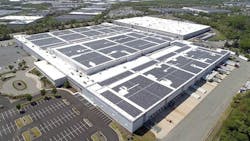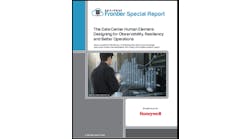The Outlook on Data Center Sustainability in 2022
In this edition of Voices of the Industry, Chris Pennington, Director of Energy and Sustainability at Iron Mountain Data Centers shares thoughts on what will drive data center sustainability efforts in 2022.
Chris Pennington, Director of Energy and Sustainability at Iron Mountain Data Centers
We all know the realities of climate change and the importance of making positive changes to our past practices. From wildfires in my home state of Oregon to hurricanes in the Gulf and changing weather patterns across the globe, the need to make meaningful change, quickly, is clear.
The data center industry has a unique opportunity to play a meaningful role in combatting climate change and I’m pleased to report that progress is being made. The industry is proving to be a force for positive change by setting clear, ambitious goals to reduce environmental impact and consistently ranks among the top consumers of clean energy around the world.
Our positive impact is poised to grow as more businesses abandon carbon-heavy on-premises data centers and migrate to greener infrastructure operated by cloud platforms and colocation facilities. In short, the outsourced model is demonstrating a path to a greener digital future.
While much has been accomplished, there is still more work to do. Data centers still utilize carbon-intensive generators for backup power and the overall percentage of clean energy on the grid is still small. These are largely technology challenges that will require innovation and time to overcome.
Fortunately, today more than ever before, it is clear that we no longer need to choose between the planet and profit. The more sustainable solutions are reducing risks and improving profitability for companies, making for good business practices that can also benefit the communities in which we operate.
What is Driving Sustainability Efforts?
Data center customers are driving change within the industry in meaningful ways. While large cloud computing companies led the charge for greener data centers early on, they are not alone. An S&P 500 report found that 86 percent of companies published sustainability reports in 2018. As more companies from all sectors adopt their own goals for sustainability, they naturally look to their supply chain for partners that can help them succeed. As most companies have an IT demand, data centers represent an important element of their energy footprint and supply chain.
In a recent survey by 451 Research, almost a third of multi-tenant data center (MTDC) representatives said all their customers wanted contractually binding commitments to efficiency and sustainability. Another 44 percent said this was true for most of their customers. Companies with sustainability commitments can simply no longer afford to use MTDC providers that don’t prioritize carbon free, sustainable solutions.
The Data Center Industry’s Sustainability Journey
The data center industry’s path toward sustainability has been a steady march that began in 2007, when the largest data center operators, from Google to Facebook to Amazon, started to improve the efficiency of their equipment and data center facilities. Others began to take notice as that relentless focus on efficiency yielded huge savings in electricity and slashed the carbon impact of these businesses. These were early examples of reducing carbon and costs, clearly making the business case for sustainability.
In the next step of the industry’s sustainability journey, large data center operators focused on procuring renewable energy to power their operations. The innovative procurement methods pioneered by the largest energy users cleared a path for companies from all sectors, making renewable energy more accessible to many more.
Multi-tenant data center providers, like Iron Mountain, recognized a key link was missing. The majority of energy consumed at our facilities is actually by our customers, and we therefore needed a clear protocol to pass through to them the benefits of the clean energy we were buying.
In an early example of industry collaboration, working under the moniker of Future of Internet Power, multi-tenant data center providers along with non-government organizations established the protocol that exists today for our customers to recognize the energy consumed at our sites as clean. Moving an on-premise data center to a multi-tenant provider has now become one solution for companies seeking to reduce their carbon footprint and achieve renewable energy goals.
These efforts have laid the groundwork for the next phase of the data center industry’s sustainability journey — building on what we have accomplished to create a more comprehensive positive impact. Transparency, collaboration and innovation will all play critical roles in the journey ahead. Our role as a critical supply chain component for our customers will become only greater, and enable us to become an accelerated, even more effective force for climate action.
Looking Ahead
While clean energy procurement by data centers may sound like old news at this point, we’re far from done with supporting grid decarbonization. In 2022, it will be important to build on renewable energy success by seeking ways to make that procurement even more impactful. And while touting the gigawatt hours of renewable energy purchased has been a catalyst for clean energy procurement, we need to focus our attention on the end result that is needed – decarbonization.
As we all share the same atmosphere, a global effort is needed to accelerate decarbonization. The 24/7 Carbon-Free Energy Compact is an example of global companies, policymakers and organizations working together to accelerate the decarbonization of grids by adopting and advancing clean energy. 24/7 carbon-free energy (CFE) means that every kilowatt-hour of electricity is met with clean electricity generation every hour of every day, everywhere.
Matching a company’s entire electricity use with clean energy purchases, each hour of every day, is a significant challenge today. It requires an understanding of hour-by-hour energy use that most companies may not have, and knowledge of where and when renewable power is generated.
Though challenging, there are real benefits to this focus. It can help companies identify energy efficiency projects that reduce energy consumption or minimize periods of peak demand on the grid. Knowing the specific hours under-served by clean energy, including how often it occurs, the duration or seasonality, enables us to focus investment where it is needed for new clean energy solutions that will meaningfully decarbonize our grids.
This shift in focus towards making an impact on decarbonization is catalyzing an ecosystem of providers that will be necessary for our success. Traditional retail electric providers are innovating retail solutions that make 24/7 carbon free energy an ‘off the shelf’ product. Innovative technology firms are developing software platforms that will help companies identify their results and progress towards decarbonization.
Renewable energy registries are innovating methods to move clean energy tracking from the current quarterly or annual practice to hourly, or even less. These are solutions that didn’t exist a year ago, and some are still not yet matured but moving quickly. It is clear that the way we will be keeping track of our progress in the future is moving from gigawatts to CO2e.
Sustainable Construction Strategies
As an industry that is expanding its physical footprint every year, we must focus on sustainable construction strategies, starting with site selection and carrying through to commissioning. The connection between Sustainability teams and Design/Construction teams has never been more important and will continue to become more so. In an industry that has no appetite for risk, innovation can be difficult. Taking prudent measures to explore new technology, pilot and scale will require regular collaboration among these teams and with customers.
Green Building Certifications are an excellent platform to ensure we’re constructing high performing facilities and serves as an efficient method for communicating progress externally. At Iron Mountain, we’ve adopted BREEAM, the leading sustainability assessment method for master planning projects, infrastructure and buildings, as our global standard for designing, constructing and operating data centers. Our customers and prospects are often familiar with this standard, streamlining our discussions on what they can expect from our future facilities.
Sustainable Operations
A comprehensive focus on efficient operations will build on innovative clean energy procurement and green building strategies. While Power Utilization Effectiveness (PUE) will remain a staple key performance indicator, water (WUE) and carbon (CUE) are becoming important additions. Responsible water usage is critically important in a growing number of markets and causing data center operators to reconsider cooling system design, possibly upgrading older systems to reduce total water consumption.
A strong energy and environmental management practice, using ISO standards for example, adds value to these programs by using third party validation of practices and results. It is the discipline and rigor of these programs that drives performance improvement over time, and ISO certification separates good intentions from demonstrated continuous improvement.
A focus on waste can complete the full picture of data center sustainability, including waste materials to landfill and wasted heat that burdens our cooling systems. We’re adopting the UL 2799 standard for measuring and reporting waste diversion rates and support our development of circular product solutions. While waste heat reclamation and repurpose opportunities are often location specific, there are innovative ideas emerging for how to capture value from low grade heat.
Commitments and goal setting are critical to all the above opportunities and an important first step of the journey. As an industry, we have a responsibility to reduce our climate impact and the opportunity to lead by example. The Climate Neutral Data Centre Pact is an example of how we can come together as an industry to reduce our carbon footprint and improve sustainable practices across energy procurement, facility construction and long term operations.
Chris Pennington is the Director of Energy and Sustainability at Iron Mountain Data Centers. Chris has been with Iron Mountain for 30 years in various roles and was instrumental in developing their industry leading energy program.





